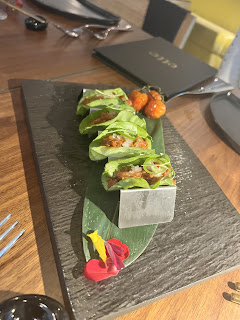Chef Akira Back’s Salt & The Cellar, ensconced at ette, one of Orlando’s newest concept hotels, is currently providing one of the most scintillating dining experiences on offer in the city. I was alerted to the restaurant, and it’s fare, by two separate sets of friends who dined there and left singing its praises. I had to investigate.
The ette hotel is located in the heart of one of Disney's tourist zones, in close proximity to some of the Disney attractions. Access is via exit 64 on I4 and then travelling westward on Irlo Bronson Memorial Highway. Given the traffic volumes in this area, it is prudent to add to your travel time budget in order to ensure timely arrival.
The restaurant is described in its literature as "an Innovative Mediterranean Asian restaurant serving breakfast, lunch, afternoon tea and dinner." It does not serve alcoholic beverages, offering instead a number of inspired mocktails prepared by a resident mixologist. These mocktails are made-to-order and a number of them are finished tableside. Winelovers are encouraged to bring their own beverages for corkage-free consumption.
As you drive under the hotel overhang, the car doors are opened by the valet and a Bellman, the latter of whom asks if we are here for dinner and the name for the reservation.He relieved me of my wine bag as he escorted us inside to the Hostess stand. He passed us, and my wine bag, onto the hostess who verified our reservation and then led us to our table. Once seated we were presented with the food and mocktail menus.
 |
| Menu entry point |
 |
| Menu jump page |
 |
| Food menu |
The restaurant decor is eye-catching, as is the color-coordinated staff attire. The ambience and service up to this time served to reassure us of the pleasing experience to come.
The table setting was immaculate with chopsticks available for those so disposed. Each table sports an ice-filled bucket for chilling wines or champagne brought in by customers.
Our waiter was Paul and he showed up brandishing the bottle of English Sparkling from my wine bag (the bag had been deposited with the bartender by the hostess) and immediately plunged it into the ice bucket at our table. He the proceeded to tell us about the restaurant, the pedigree of the chef, the restaurant philosophy, and how staff training reflected that philosophy. After taking water orders, he went over the mocktail menu.
Parlo and Ken opted for mocktails with the former ordering the Foreshadow and the latter Into the Woods.The tableside presentation of the mocktails was elevated. Both Parlo and Ken were pleased with their orders with Parlo going on to order Where the Clouds End (too thick, she said) and Hidden Path (she loved).
 |
| Foreshadow: Coconut, Cleared Pineapple, 0% White Rum, Citric Syrup, and Jelly with Coconut |
 |
| Hidden Path: Crodino, Balsamic Vinegar, Ginger Ale, Dehydrated Strawberries, 0% Gin, Acorn 0% Vermouth |
 |
| Where Clouds End: Yuzu Tonic, Lemon Cordial, Espresso, 0% Coffee Liquor |
Into the Woods: Fresh green herbs, ginger, cucumber,
lime, cookie crumble, forest aromatic mist
In the intervening period I had scanned the QR Code and gained access to the menu. We set about ordering appetizers. Paul had alerted us to the fact that all dishes would be placed in the center of the table and would thus be shareable. We ordered the Grilled Eggplant, Akira Back Tuna Pizza, and the AB Wagyu Tacos. Parlo is Gluten-free so Paul said he would have the Chef prepare an appropriate option for her. That option turned out to be something he called Beyond Tacos, a plant-based filling inside lettuce leaves.
The tacos were very flavorful and were livened up with a touch of spice.There was an exciting contrast between the pizza base and the raw tuna. I enjoyed all of these dishes immensely.
 |
| AB Wagyu Tacos |
 |
| Beyond Tacos |
 |
| Akira Back Tuna Pizza |
 |
| Grilled Eggplant |
We followed the appetizers with a Black Miso Cod course and followed that with a Caesar Salad and Togarashi Fries.
 |
| Black Miso Cod |
 |
| Caesar Salad with Tofu dressing |
 |
| Togarasi Fries |
For our main courses we had the New York Strip and the Jidori Chicken with Vegetable Fried Rice and Roasted Broccoli as sides. The Chef recommends that a minimum of three salts be added to the steak to complete its seasoning. The selected salts were brought to the table when the steak was delivered.
 |
| Jidori Chicken |
 |
| Vegetable Fried Rice |
 |
| NY Strip Steak |
We had the Yuzu Curd for dessert.
 |
| Yuzu Curd |
This was an absolutely stunning evening. This was a Michelin-Star-worthy dining experience. As Parlo described it, "this was one of my best dining experiences in Orlando. The food, service, and ambience were all excellent and the environment was relaxing. It was worth every penny that we spent."













